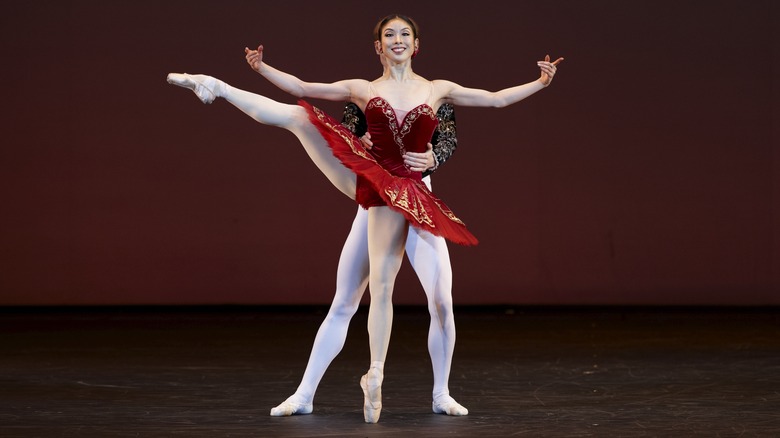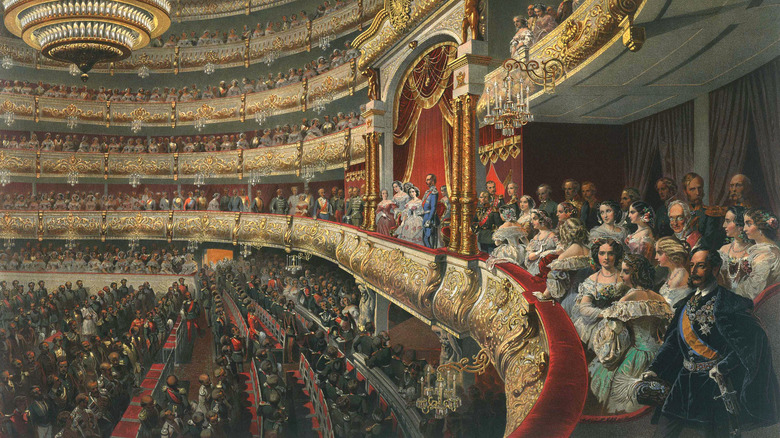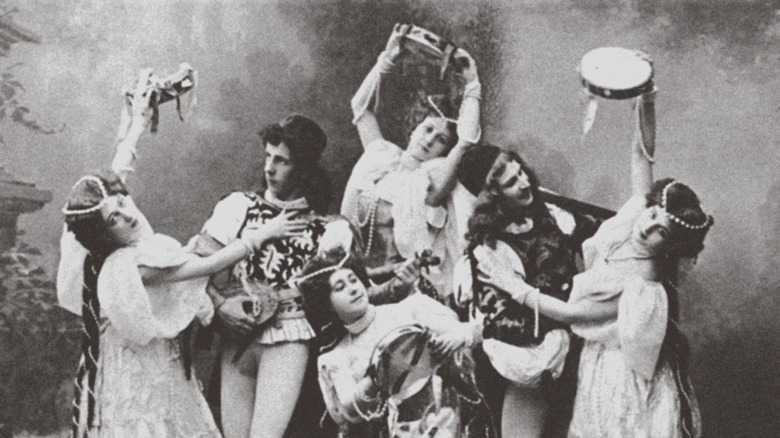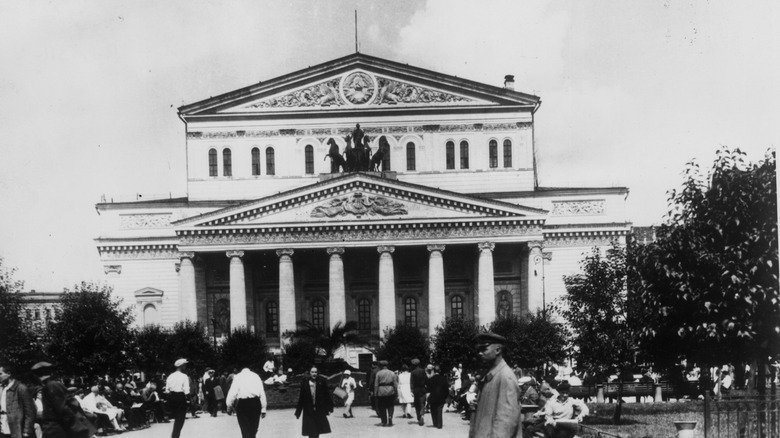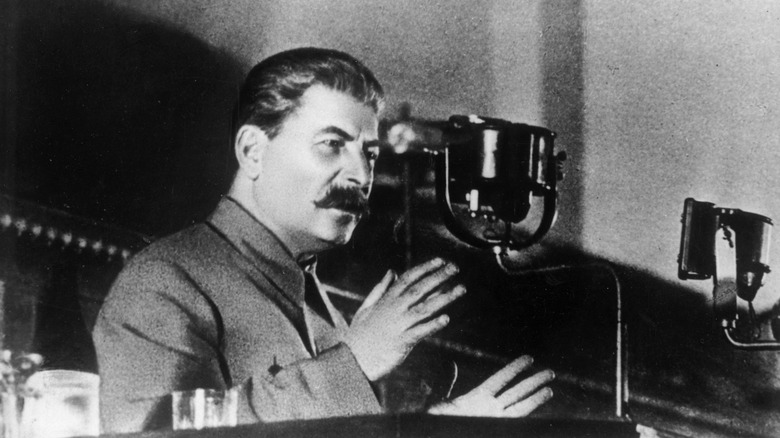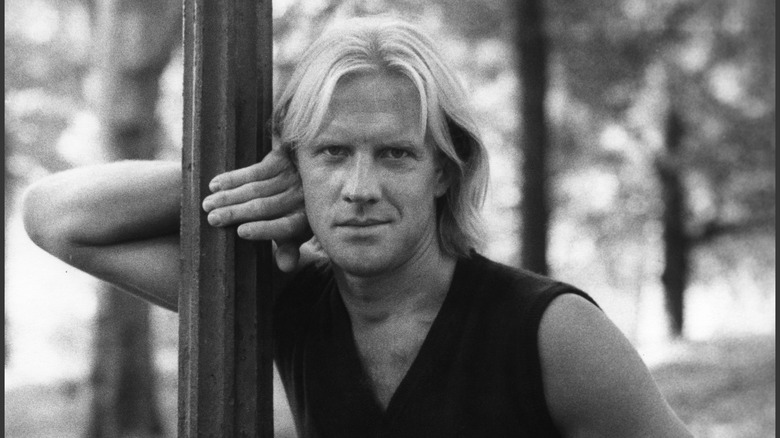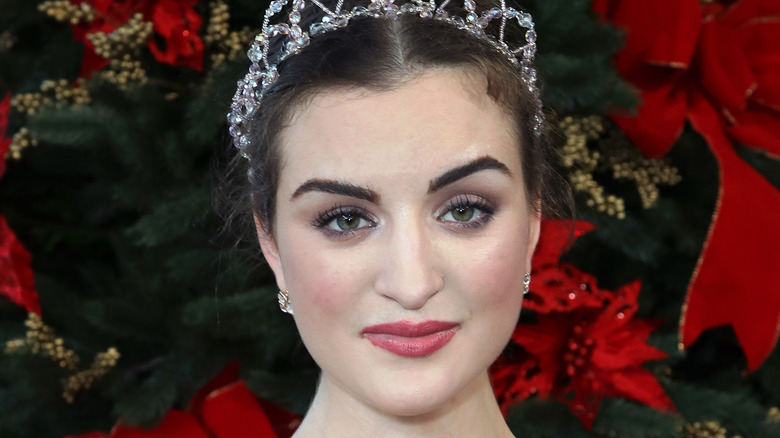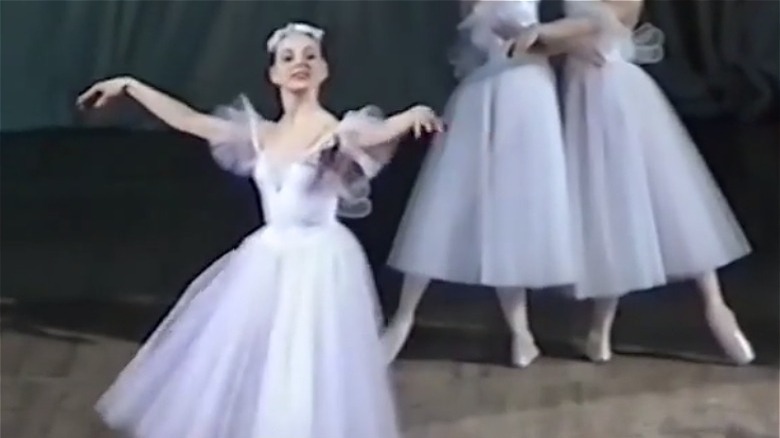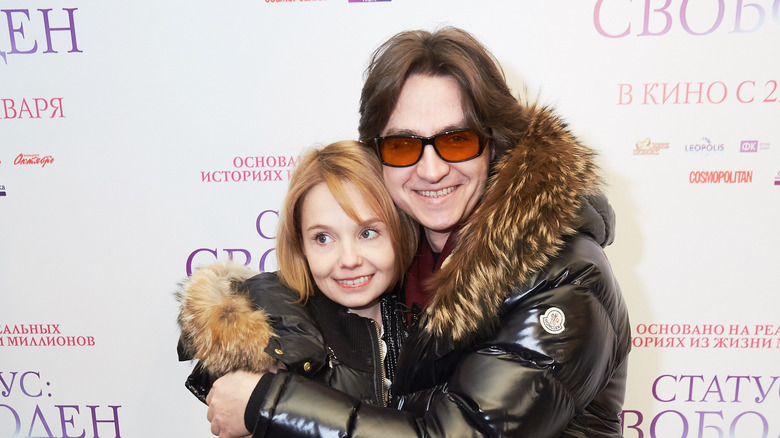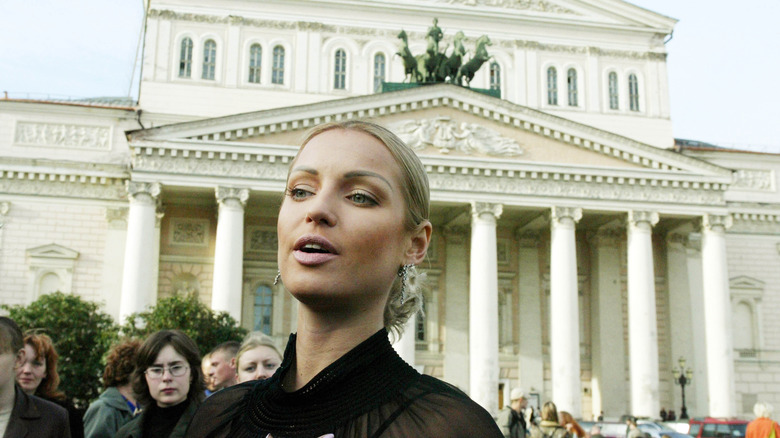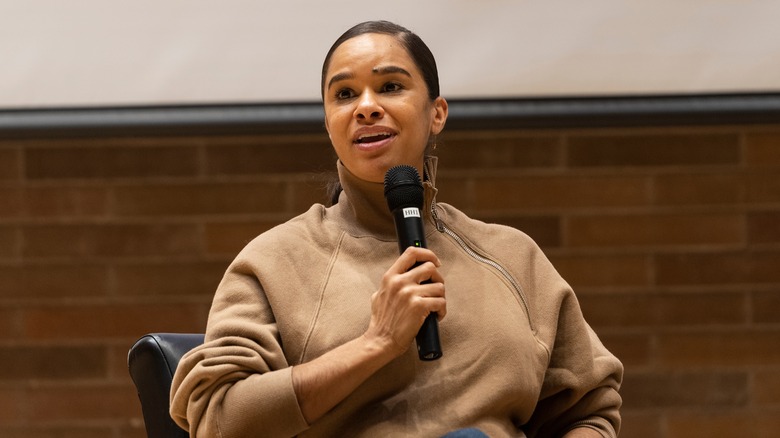The Bolshoi Ballet's Biggest Scandals And Controversies
Content warning: The following contains details of suicide and sexual assault.
The world-famous Bolshoi Ballet troupe is synonymous with grace and sophistication. Yet Bolshoi dancers have been involved in an astonishing number of seedy scandals over the years — and they just keep coming.
Starting from fairly humble beginnings in the late 18th century, Bolshoi dancers had quite the reputation. Known for sex and catty drama, Russian aristocrats flocked to their shows — not to get a dose of culture but to get a glimpse of the ladies backstage. Today things have not changed that much: headlines of Russian tabloids, sex scandals, and vicious infighting still plagues the prestigious ballet troupe.
Politics too has been a big part of the Bolshoi's history. Ballet performances have often been loaded with politically charged meaning. Especially under Joseph Stalin, putting an ideological foot wrong on the stage could result in untimely death. In the 21st century, cultural wars over the ballet, as well as the war in Ukraine, have brought the Bolshoi under intense scrutiny once again, both nationally and internationally. The dramas that play out behind the curtain are almost as riveting as those on the stage.
Abuse and exploitation in the 18th-19th centuries
The Bolshoi may conjure up images of high-society living but the dancing group had a surprisingly ignominious beginning. The Bolshoi Ballet troupe was founded by a shady character, a mysterious Englishman, Michael Maddox. In 1780, Maddox went into business with a nobleman, Prince Pyotr Urusov, who had been given the right to create the Petrovsky Theater in Moscow, the precursor to the Bolshoi. The ballet troupe was largely populated the Moscow Foundling Home, a government-run orphanage supported by Catherine the Great to educate and bring up a "third caste" from these abandoned children, notes Simon Alexander Morrison in "Bolshoi Confidential." These children were already being schooled in music and dance and had long been coached to entertain the public as part of a scheme for their betterment begun under Catherine. When making the arrangement, Maddox even went to far as to assure officials he wouldn't sell the girls for money. However, the childrens' lives weren't vastly improved — they were poorly paid as performers and had already suffered abuse as wards of the government.
In the early 19th century, the Imperial government took over the running of the organization. However, the dancers were still not always particularly well-treated. One of the earliest dancing masters to work at the imperial Bolshoi, Thomas Guerinot (appointed in 1838), caused a scandal when he was fined for savagely slapping and kicking one of the ballerinas backstage. On occasion, the ballerinas also received abuse from the crowd, who were heavily invested in the politics of the stage. In one particularly memorable incident in 1848, a dead cat was thrown at one of the dancers, a mocking note pinned to its tail.
Ballerina Avdotya Arshinina' s sexual assault and death
In the 19th century, it was not unusual for ballerinas to double up as sex workers. In cities like Paris and Moscow, wealthy men were often granted access to ballerinas' bodies in return for financial contributions. At the Bolshoi, the less famous dancers were often pressured into sex work while the superstars of the stage had glamorous affairs with prominent noblemen and even royalty. Tsars Nicholas I and Alexander II, for example, were known to have a particular fondness for dancers.
In one particularly famous case highlighted by Simon Alexander Morrison in "Bolshoi Confidential," the sexual wheelings and dealings at the Boshoi took a very dark turn that shocked Moscow. A young ballerina named Avdotya Arshinina was left at a hospital beaten and delirious, after being sexually assaulted by a gang of aristocrats. Arshinina had been sold to Prince Boris Cherkassky by her own father, one of many women in the world of ballet who were exploited in this way by the rich. She died 13 days after arriving at the hospital. Both Cherkassky and Arshinina's father were questioned during an investigation, and her father was actually sentenced to two years in prison and then banished from Moscow. However Cherkassky was never convicted due to inconsistent eye-witness accounts.
The Red Poppy ballet saw suicide on-stage and was deemed offensive in China
After the Russian Revolution, the Bolshoi changed a great deal to keep up with the new zeitgeist and to avoid persecution. In 1927, "The Red Poppy," a popular new ballet laced with Marxist ideology, debuted at the theater. The ballet was fairly successful in Russia, achieving a fairly long run; however, it is now best remembered for causing several dramatic scandals.
As Simon Alexander Morrison details in "Bolshoi Confidential," in 1928, two female ballerinas died by suicide on stage during a performance of the show, leaping together from the top-most part of the stage during a death scene. The suicide did not go as planned, however — one of the women did not die right away but was horribly injured by the fall and left rolling around on the ground in agony in full view of the audience. The curious leap of death was explained at the time as a failed romance. According to a 1928 article in The New York Times, both women had been in love with the same man and had killed themselves over the affair. True or not, the man in question was later arrested in connection with the case and sent to prison.
In 1950, the ballet also caused a diplomatic incident: Although the show was intended as a left-wing critique of British imperialism in China, the now-communist Chinese found it deeply offensive. The use of a Chinese hair braid (a sign of Manchu oppression) and the title's reference to opium caused a clamor. The ballet was later re-written as "The Red Flower" in 1957 to appease Mao Zedong.
Censorship and purges under Stalin
As Vladimir Lenin's rule gave way to Joseph Stalin's, restrictions on the arts tightened further. The ballet was now cursed to suffer the whims of the new dictator, and some very prominent figures came into the firing line, both literally and figuratively. The head of the Bolshoi in the mid-1930s, Vladimir Mutnikh, was executed during Stalin's purges.
Mutnikh's death cast a long shadow over the ballet. One of the greatest artists to ever work with the Bolshoi, Sergei Prokofiev, was putting together his famous ballet, "Romeo and Juliet," when Mutnikh was in charge. Prokofiev had moved to Russia to bolster his career, but his working relationship with Mutnikh landed him in hot water. Eyed with serious suspicion from then on, the ballet was temporarily postponed, and Prokofiev was barred from leaving the USSR altogether. Some of Prokofiev's colleagues who worked on the production were also executed, including the resident scenarist who worked on the piece, who was charged with treason. According to Simon Alexander Morrison's "Bolshoi Confidential, his only crime was a dislike of the new artistic restrictions.
Alexander Godunov defects to the west
Under Soviet rule, some Russian artists found the restrictions on their lives too much to bear and made a run for it to the West. At the Bolshoi, a particularly high-profile dancer, Aleksandr Godunov, made headlines around the world, and caused a scandal in Russia, when he left for the United States and never returned.
Writing for The Washington Post in 1979, journalist Robert Larkin detailed his time nearly five years earlier with the dancer. Godunov had told the reporter that he could not stand the limitations on his work and longed to flee Russia for the west. At the time, Godunov had been barred from leaving the country for four years due to his behavior the last time he left the country.
When the restriction came to an end, Godunov packed up and left and was awarded asylum in the U.S., which kept him safe from any reprisals. Godunov was not the first Russian dancer to escape the USSR, but he was the first from the prestigious Bolshoi elite. In an interview with The Christian Science Monitor, the dancer spoke passionately of his limited chances to perform in Russia, as well as his love of the freedom America offered. A great admirer of American individualism, Godunov went on to become a celebrity in America, pursuing a short acting career before his early death due to alcoholism in 1995.
The Bolshoi bribery scandal
The modern Bolshoi has routinely been subject to rumors of corruption — including accusations that staff award prized parts to dancers in exchange for sexual favors, or gave primacy to those with powerful political connections. In 2013, American ballet dancer Joy Womack caused a storm of controversy when she told the press that she had been offered a prestigious solo part at the ballet in exchange for $10,000.
According to The New York Times, when Womack balked at the extortion she was told, "Don't you understand that you are an American? ... You have to be smarter about this. You have to find out who you have to pay." Womack told the press that the Bolshoi is rife with shady practices and alleged that on another occasion she was offered financial support in exchange for sex.
Womack claims she was not given the role she was promised and spent very little time actually performing. Exasperated by her experience, she chose to tell the world in an interview with the Russian news outlet, Izvestiya, damaging the Bolshoi's reputation. Director of the Bolshoi, Vladimir Urin, responded to the uproar by stating that Womack should consider legal action against those who were to blame.
The disturbing disappearance of Olga Demina
In 2014, famous Bolshoi ballerina Olga Demina vanished in a disturbing case that left many loose ends. Demina's manager, Malkhaz Dzhavoev, who has been named as the dancer's lover despite being married, is believed to be the killer. While serving time in prison on housing fraud charges, Russian police claim Dzhavoev confessed that he dissolved her body in acid.
According to Demina's relatives, the dancer's relationship with Dzhavoev was a dark one. Dzhavoev is supposed to have blackmailed the ballerina using nude photographs, asking for money in exchange for his silence. According to Yahoo News, Demina's mother has stated that her daughter took out loans and even sold her car to pay her manager off. Demina's boyfriend, who was also connected to the fraud case, was named as another potential suspect.
Dzhavoev has maintained his innocence, arguing Demina fled abroad with money from a housing scam, although it's unclear is in relation to his own fraud charges.
A dancer attacked artistic director Sergei Filin with acid
In January 2013, the artistic director of the Bolshoi, Sergei Filin, was opening the door to his apartment building when a masked man approached him and threw a jar of sulfuric acid in his face. The terrifying assault left Filin in agony — his face was maimed with third-degree burns, and he temporarily went blind. Even after surgery, his right eye was left almost useless.
Sadly, Filin was well aware he was in danger in the months leading up to the attack. The director had been experiencing a great deal of harassment, having had his tires slashed and his inbox hacked. It transpired that the man who threw acid at Filin was working for one of the Bolshoi's dancers — Pavel Dmitrichenko — a man believed to have a grudge against the director for passing over his girlfriend for the lead in "Swan Lake." It was found that Dmitrichenko had paid one of his two accomplices 50,000 roubles to plan the attack.
FiIlin was left in a state of serious psychological shock, was forced to step down from the Bolshoi for a time, and undertook numerous operations to repair his face and eyes. Nonetheless, Dmitrichenko was unapologetic when he came to trial along with the two other culprits. While at trial, the case created a second scandal after Dmitrichenko accused Filin of several major indiscretions, including improper use of funds and sleeping with the dancers.
Sexual abuse may be going on according to one high-profile whistle-blower
In the 21st century, lurid sex-related allegations are still being made against the Bolshoi. In 2013, celebrity ballerina Anastasia Volochkova claimed that just like in the 19th century, ballerinas are still routinely sexually exploited. Volochkova is one of the most famous ballerinas in Russia, and she has been involved in several high-profile controversies over the years, including being fired for being too heavy for the ballet.
Speaking with the Russian News Service, Volochkova claimed that the Bolshoi acted as a brothel behind the scenes, pushing staff to have sex with wealthy oligarchs after shows. Those who refuse risk losing their jobs. According to the BBC, Volochkova stated, "The girls were forced to go along to grand dinners and given advance warning that afterward they would be expected to go to bed and have sex ... " The Bolshoi's director at the time, Anatoly Iksanov, dismissed Volochkova's claims as "ravings."
According to The Moscow Times, Volochkova herself appears to have participated in illicit activity of this kind. The ballerina was slapped with a prostitution charge a year later when a tape recording emerged of the ballerina offering sexual services for money. The charges were dropped because the statute of limitations had run out, but the uproar just added to the controversy surrounding the Bolshoi.
Blackface at the Ballet
A Bolshoi rehearsal of the classic ballet "La Bayadère" caused an international spat in 2019 when American ballerina Misty Copeland posted a picture of Russian dancers on Instagram. The two women pictured in the image were dressed in blackface, with just a fine ring of pale skin left around their eyes. Copeland, who is the first African-American woman to work as the principal dancer for the American Ballet Company, complained that the ballet world was rife with problems of this kind. She also stated that ballet groups were still more likely to use makeup than hire dancers of color.
The ballet in question is set in India, and some commentators dismissed the accusations of racism as a uniquely American point of view. In some parts of Europe, the use of blackface makeup has never been particularly controversial. The Bolshoi said it would not discuss the matter and continued to use the blackface makeup. In response, the girls Copeland posted about deleted their Instagram accounts.
Bolshoi shows shut down over the Ukraine War
When Vladimir Putin's war against Ukraine began, many performers and creators hailing from Russia's art world publicly presented a united front against the conflict. In response, some artists who expressed their opposition to the war, including ballet creator Kirill Serebrennikov, have had their shows terminated.
The biggest uproar came when prima ballerina Olga Smirnova left the Bolshoi ballet to work for the Dutch National Ballet and openly criticized the war on social media. Pulling no punches she said, "I never thought I would be ashamed of Russia ... But now I feel that a line has been drawn that separates the before and the after" (via The Guardian).
Smirnova was the first of the Bolshoi group to leave Russia altogether, citing concerns for her own safety (via The New York Times). She was joined by many others, including legendary choreographer Alexei Ratmansky. Across Europe, many Western governments have also responded to the war by halting all collaboration with the ballet, and Russia has retaliated, refusing to work with Western artists in return.
